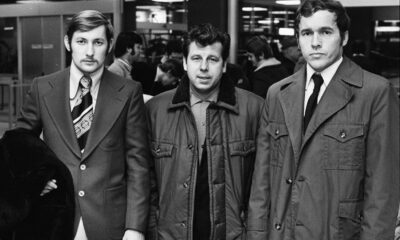Football
A Screen to the Past: The famous Ladislav Kubala fled the totalitarian regime in the uniform of a Soviet soldier

He played for three national teams: the Hungarian, Czechoslovak and Spanish national teams. He led the Spanish and Paraguayan national teams. Ladislav Kubala earned a worldwide reputation as a player and coach. The renowned football historian Lubomír Král describes how difficult his journey to the democratic establishment was in his three-volume work ‘Football Fates’, published by Epocha.
László, Ladislav or Ladislao lived an extraordinary life story, which is captured in the volume ´All Good (Football) Natives´. His football career was admirable, both on the pitch and later on the bench.
Far more compelling, however, were his life’s journeys, literally the subject of an Oscar-winning screenplay for Hollywood movie studios. In order to develop athletically and humanly, he had to leave the communist regime that engulfed half of Europe after World War II, even his native Hungary.
But let’s give the author his word: “Hungary followed the same line as Czechoslovakia, the Hungarian secret state police Államvédelmi Hatóság began circling around Laco, and Vasas’ promise to leave for an Italian engagement was not realized. December’s league games, which were his last, were also his last.
With an overall record in the Hungarian league of 80 games and 46 goals, it was his last Hungarian Christmas. His wife, Daučík’s sister, Anna Viola, who was called among the closest people Ibojka, had already returned to Czechoslovakia after an agreement with Laco. She stayed with relatives in the south of Slovakia, in Šahy, and gave birth to her first son, Branislav Kubala, in January 1949.
At the same time, Laco had been preparing his illegal departure to the West for several months, together with his teammate from Vasas, György Marik. In a group with several other refugees, all dressed in Soviet soldiers’ uniforms, with documents in Cyrillic, on the back of a truck with a license plate written in Cyrillic, they made an adventurous and at the same time somewhat crazy crossing of the Hungarian-Austrian border. We succeeded!
Another, far more difficult one was the crossing from the Soviet occupation zone to the American zone. Already in civilian clothes, in winter, on foot and especially at night, the refugees reached the French zone, Innsbruck. This was followed by a few days in a so-called screening centre, where the identity and possible “defectiveness” of each person was verified. This obstacle was also overcome and Laco found himself in Switzerland, from where he immediately crossed over to Italy.
And back home in Slovakia he sent a message to his wife that it was time for her to leave as well. Even that was not any easier in terms of drama and danger. In March, when her departure was already prepared and agreed, it happened. With the help of a ferryman who knew the terrain and the possibilities of crossing the Danube.
The then two-month-old Branko was firmly strapped to an inflated tire from the truck, and with this “luggage” Iboyka crossed the icy river to the Soviet occupation zone, to Austria. With the help of other smugglers, which was certainly not free, she gradually reached Switzerland and then Italy.”
Other similar stories can be found in Lubomír Kral’s publication Football Fates.












